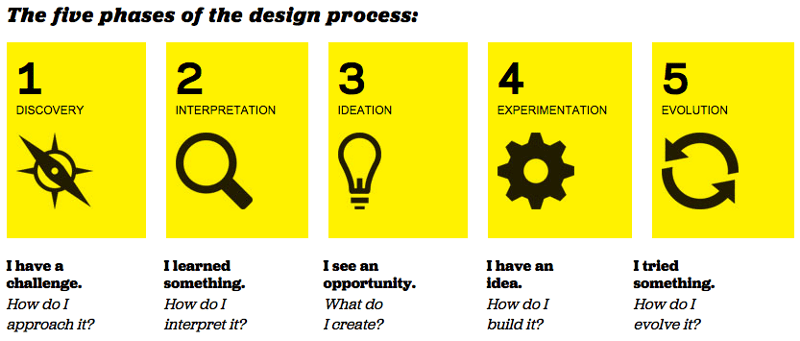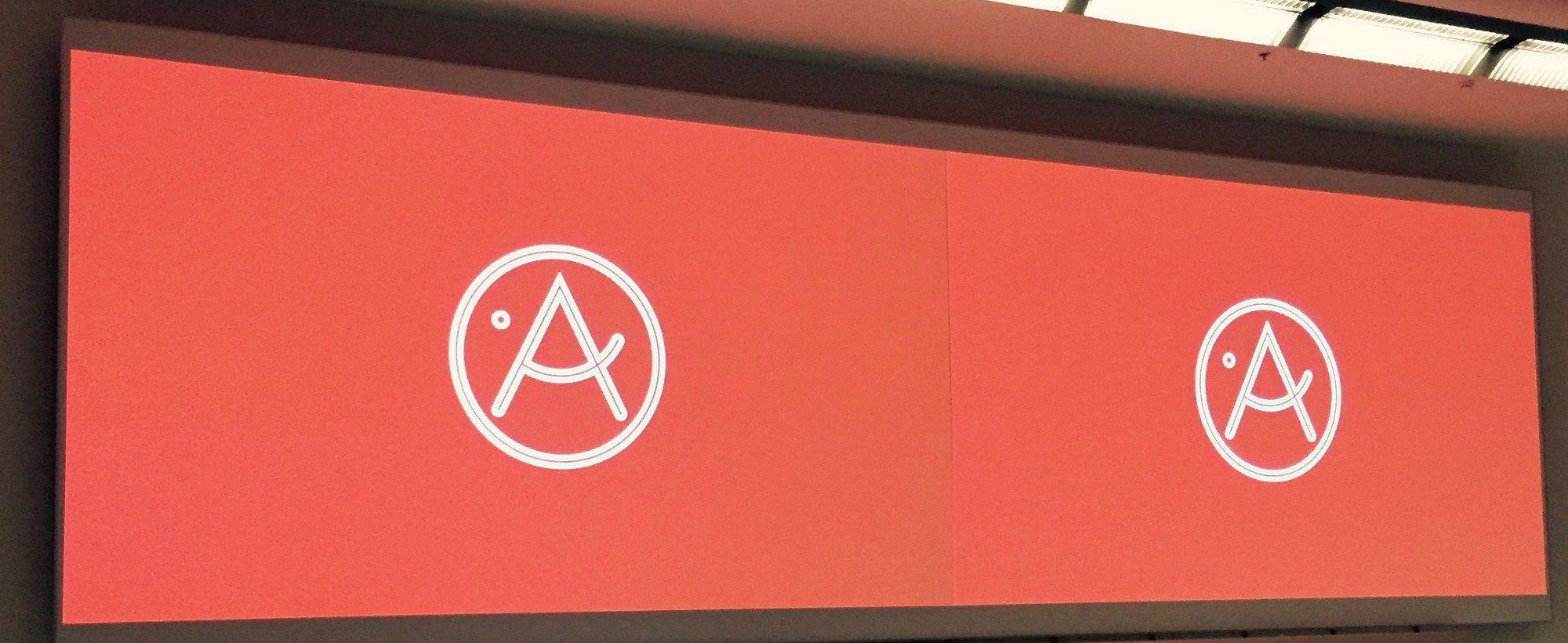Design thinking + business model innovation
There has been a lot of buzz around designing new and innovative business models. But what does it mean to design a new business model? How do you apply design thinking to business model innovation?
Wednesday, August 26, 2015
A lot has been said and written about what design thinking is, so I will not go there. Instead, I will take a typical design thinking process and show you how it can be applied to business model design.
As the design firm IDEO has been one of the early advocates of design thinking, let us use one of their design thinking processes as outlined in the Design Thinking for Educators Handbook. Other processes are fairly similar and I found this one to be easy and clear enough to be understood quickly by people without a design thinking background.
The design process has five phases: Discovery, interpretation, ideation, experimentation, and evolution.

Source: designthinkingforeducators.com/design-thinking/
1. Discovery
The discovery phase is all about gathering data. You want to gain inspiration for your new business model. The question is where to look for this inspiration. One of the principles of design thinking is to start with people, aka customers, and trying to understand their needs and frustrations. There is actually a growing body of evidence that looking outside of your company and to customers’ needs will lead to more innovative ideas, than purely looking internally. Solving customers’ needs is the key to a successful business. So you will need to go outside. (Note that I wrote to you! Don’t outsource this to a market research agency. Get first-hand experience!) Talk to customers. Satisfied ones, unsatisfied ones, potential customers, people who would never buy your product or service, and also people you have never considered as a potential customer. Talk to your competitors’ customers. Ask them about what makes them happy with the current businesses and offerings in the industry, why they buy or do not buy from you, your competitors, and other industries. Ask them about their job-to-be-done or need to be fulfilled and their expectations. Try to understand the steps in the customer journey they need to take, what delights and frustrates them. What are their pain points?
The design process is what puts design thinking into action. (IDEO)
Besides the customers, it has also proven helpful to look at the typical business models within and outside your industry. Understanding the logic of how an industry works and what its dominant business models are, can often help to identify what is not working well in the industry and why. Services like the Business Model Gallery can help you to gather data on existing business models.
Besides looking outside of your company, you might also want to talk to your “internal customers” and ask them what they think about the way you do business or assess what your company is really good at, what skills, capabilities and assets it possesses that can be leveraged. Such things can be particularly interesting for established organizations. Often you do not need to depart far from your existing business area to invent a completely new growth business with a new business model.
2. Interpretation
Once you have gathered the data, you need to make sense of it and try to understand it. The objective of the interpretation step is to articulate a clear and compelling opportunity you see in the market.
In the case of business model design, several design thinking frameworks for looking at your data have proven particularly helpful. Customer journey mapping for example not only helps to understand the customer’s experience, frustrations, and pain points within it but also to identify steps in the journey that are not being addressed by the current offerings and business models in the industry. Make sure you clearly understand what the customer is trying to achieve, what his job-to-be-done is, and what makes the current customer experience unsatisfying. What are the barriers to consumption and the hurdles to satisfaction? You can use personas to describe representative customer groups, their particular experience, needs, and pain points. Visual thinking is of course highly recommended!
At the end of your interpretation phase, you should be able to articulate clear opportunities for innovative business model designs. It often helps to articulate these as what I call “breakthrough questions”. A breakthrough question is something like, “How can we give away our product for free, while still earning money?” Breakthrough questions should be challenging and inspiring. They should look impossible to answer at first. Questions like these will lead to truly innovative business models.
3. Ideation
Ideation is about developing ideas on how to seize the opportunities you have identified above. What are the possible answers to your breakthrough questions? In my experience, having a deep understanding of the customer, her needs, and pain points, as well as the existing solutions, i.e. business models in the industry, will naturally lead to ideas. How seriously you do your discovery homework will determine not only how fast you create ideas, but also about how likely these ideas are to succeed. Using classic brainstorming, think about conversation starters like “How might we…” or “What if…”. Approaches like the Blue Ocean Strategy Canvas and the Eliminate, Reduce, Raise, Create can also spark your imagination. Learning from other industries and business model innovations can of course also provide inspiration. You can use a template like the business model canvas to summarize and structure your ideas.
To evaluate your ideas, you can use the 3 types of value propositions. Evaluate each idea regarding the value it creates for customers, your company, and your ecosystem. If you score on all three, you’re likely to have developed a good idea holding the potential for a successful business model.
4. Experimentation
Contrary to the popular notion that you need to experiment with alternative business models, I find that the most successful business model innovators only experiment with one business model innovation idea. Experimentation rather happens on the level of how to make this one idea work, than on the level of which business model alternative works best. Let’s be realistic: You probably do not have the resources to experiment with a dozen business model ideas at once anyway. And most often it is also not necessary. If you did your homework, and have identified a solid idea, the question will most likely be how to make it happen. And if you can make it happen, it is likely to be successful. Sloppy discovery and uninspiring questions will lead to dull ideas that are not likely to be very attractive to customers.
Experimentation does not need to be expensive or take a lot of effort though. The consulting company EdenMcCallum originally only posted an ad for its new model. The positive response it received was proof enough that there is at least an interest in the market.
Reach out to customers and tell them about your plans for a new business model and ask them what they think. When Fahrenheit 212 proposed its new business model to potential customers, one of them was so convinced he bought up all of Fahrenheit’s capacity for 6 months. Experimentation can be that easy.
Once you have validated your initial idea, start doing business. You will learn what works and what does not along the way. You will also gain insights and identify further opportunities to design your business model and make it perform even better.
5. Evolution
Evolution is about reflecting on the outcomes of your experiments and the experiences you made. You can think of evolution as the start of the next cycle of discovery, interpretation, ideation, and experimentation: You experimented and discovered what works and what does not, you gained new insights, which need to be interpreted. Based on your interpretation you ideate, fine-tune, or re-design your business model and experiment again. In practice, I see that companies repeat this cycle until they feel confident enough to scale their business model up or spread it throughout the organization to replace an existing one. Sometimes companies experiment with the first iteration of their business model for several years, before they enter the evolution phase. The most important thing is to keep on reflecting on how successful your business model is and whether it is really creating any value for all involved parties. If you are unhappy with your assessment, it might be time to embark on the next journey of discovery.
For more inspiration on how to design your new business model, visit the Business Model Gallery.
Like this article? Please hit the heart button below and share it with your friends!



